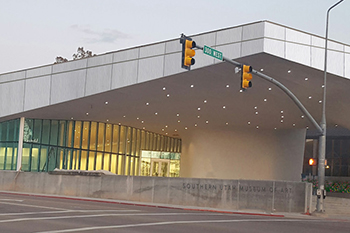 CEDAR CITY, Utah — The new Beverley Taylor Sorenson Center for the Arts in Cedar City will officially make its debut with a dedication on July 7. The center is the new home of the Utah Shakespeare Festival (USF) and Southern Utah University’s (SUU) Southern Utah Museum of Art (SUMA).
CEDAR CITY, Utah — The new Beverley Taylor Sorenson Center for the Arts in Cedar City will officially make its debut with a dedication on July 7. The center is the new home of the Utah Shakespeare Festival (USF) and Southern Utah University’s (SUU) Southern Utah Museum of Art (SUMA).
For several years, USF had been raising money towards a new Shakespeare theater, while SUU launched a campaign to build SUMA in 2009. Instead of building the two facilities separately, leaders from both organizations determined in 2012 that combining the two projects would propel both to completion and enhance the guest experience, according to Nikki Koontz, assistant director of marketing for SUU.
Construction on the $39 million project began on Aug. 27, 2014. Blalock and Partners Architectural Design Studio conducted the programming and design phases of the project, while Big D Construction served as the general contractor. Both companies are based in Salt Lake City.
The buildings that comprise the Beverley Taylor Sorenson Center for the Arts were built on approximately six acres on the Southern Utah University campus. They include USF’s new Engelstad Shakespeare Theatre, an outdoor theater meant to replace the retired Adams Theatre, as well as USF’s Randall L. Jones Theater, Eileen and Allen Anes Studio Theatre and Artistic and Production Facility. The SUMA building also makes up a major portion of the art center, featuring 5,300-square-feet of exhibit space.
All the buildings are constructed to the most recent state of Utah energy standards for high-performance buildings. “By utilizing natural light, LED light fixtures with smart panel controls, high-efficiency boilers, whole building air-barrier systems and other energy-related features, these facilities reflect the state of Utah’s understanding of the value of investing a small amount of money up front in order to save a large amount of money over time,” said Tiger Funk, executive director of facilities management at SUU.
Water conservation was also an important part of the landscape design process. Native trees, ground cover and flowers were selected to enhance the center while promoting water conservation, according to Funk. Almost all of the landscape is irrigated with drip systems and heavily mulched to prevent errant evaporation. Computerized water-management systems prevent the overwatering of areas by calculating water output based on real-time weather data such as wind speed, recent precipitation, relative humidity and temperature.
The overall form and structure of SUMA is influenced by sandstone formations found at nearby Bryce and Zion National Parks, according to Funk. “These landforms are translated into the building’s canyon-like roof, which monolithically covers the entirety of the museum as well as a 5,000-square-foot outdoor space at the main entry,” he said. “This porch blurs the boundaries between the inside and outside, and it serves an important social purpose — to reflect, engage, and promote the exchange of ideas. This unfettered movement from inside to outside cultivates an atmosphere of leisure while simultaneously providing shade to protect the art inside and still allowing for spectacular views of the surrounding mountains.”
One of the biggest challenges with the project was taking two pre-existing concepts and combining them into one unified project, according to Josh Stavros, media and PR manager for USF. “It took a lot of brainstorming and design meetings to create a modern, sophisticated art museum with a Shakespearean, old-world theater along with functional office and artistic spaces,” he said. “The design has a lot of natural wooden and stone elements and a chevron pattern. We also had to close part of a road and reroute power, sewer and gas lines, so there was a lot of communication and collaboration that had to happen with the city.”
The Beverley Taylor Sorenson Center for the Arts was named after receiving a $6 million gift from the Sorenson Legacy Foundation. Beverley Taylor Sorenson was an advocate for arts education and believed in the power and impact art has on children’s lives.

